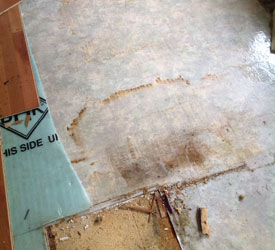Just how do you really feel about Common Causes of Water Damage in a Bathroom?

The shower room is incredibly at risk for damp buildup as well as potential water damages due to the constant use of water in it. This write-up uses simple examination techniques to aid discovering water damages risks.
The frequent use of water in the bathroom makes it very prone for moist buildup and prospective water damage. By checking it consistently, you can decrease water relevant damages.
The complying with set of assessments is very easy to carry out and also should be done when in every three months in order to keep your washroom in good shape as well as to stop prospective water problems caused by the tub, the shower, pipeline joints and plumbing, sinks, cupboards, and also the toilet
Do not disregard executing these evaluations as well as be thorough while doing them. Remember that these simple evaluations can conserve you a great deal of money by offering very early signs for water damage
Sinks as well as Cabinets
Sinks and also cabinets are exposed to wetness and also moisture daily as well as are commonly overlooked. Examine frequently under the sink and also on the kitchen counter above it. Repair any type of drip in the catch as it might recommend drain problems. Take a look around the sink, sluggish draining pipelines might indicate a blocked drain. Replace sink seals if they are split or loosened.
Bath tub and also Shower
The shower and bathtub require special interest as well as upkeep. Examine the floor tiles and replace if cracked. Ensure that there is no missing grout between the ceramic tiles. Check as well as change split caulking at joints where the wall surfaces fulfill the flooring or the bath tub. Obstructed drains pipes and also pipelines troubles will certainly stop the bath tub from drying out and also might indicate serious issues below the tub. Talk to a specialist quickly to prevent structural damages. Take notice of stainings or soft locations around the tub wall surfaces as they may suggest an internal leak.
Plumbing
Signs for water damage are tough to identify given that a lot of pipelines are set up inside the walls.
Pay special focus to floor covering and also wall surfaces wetness as well as stains as they may show an unseen plumbing trouble. Inspect moisture levels in adjacent areas also.
The Bathroom
The toilet is a vulnerable water joint. Inspect the water lines as well as search for leakages around the commode seat, in the hose pipe, and under the water tank. If you identify any type of indications of moisture on the flooring around the bathroom, check for leaks in the toilet edge as well as tank seals.
Realize that hanging commode bowl deodorants raises the possibilities for clogs.
Water Damage Signs In The Bathroom To Avoid Cleanup
Musty smell
This is one of the easiest signs to catch because musty smells are so odorous. The damp, earthy, moldy smell should be a big red flag. The smell will develop when moisture gets trapped in surfaces, and begins to facilitate mold growth. Leaking pipes under cabinets, inside walls, and behind shower fixtures will cause moisture to stay trapped and not dry, which will lead to mold growth and spread. As soon as you notice any musty smells in your bathroom, have it checked for hidden water damage and cleanup signs.
Visible mold
If the smell isn’t there to give it away, sometimes you will actually see mold growth. Finding mold in your bathroom is a serious problem, because mold is very harmful to your health. By the time mold growth is visible, it also means that water damage has already occurred and been present for some time. The only way the mold problem can be resolved is to find the source of the moisture and get it stopped. To safely and adequately remove mold, you need to have professionals handle the remediation. Do not waste any time in getting mold problems addressed, fixed, and sanitized so that you can protect you and your family from the many respiratory symptoms caused by mold exposure.
Damaged floors
Bathroom floors should be able to withstand some exposure to water while still remaining in good condition. However, when excess exposure or water leaks occur, they will begin to damage even the most water-resistant flooring. If you notice any cracking, bubbling, staining, or warping on your bathroom floors, there is probably a water leak somewhere causing the distortion. If you notice areas of the floor have become softer, or even have a spongy feeling, there is probably damage to the subfloor. Subflooring is typically made up of plywood. When plywood is exposed to water or moisture, it will absorb it. Once it has become saturated, the weight of the excess water will cause the wood to swell and soften. Check the floors in your bathroom frequently to catch any of these sings before they lead to damaged subflooring.
Changes on walls
When water leaks behind walls, it will cause changes in the drywall. Peeling plaster, blistering paint, and soggy wallpaper are all good indicators that excess water is building up behind the wall. Water leaking behind drywall will cause it to swell and be soft to the tough. If you start to notice gaps along the trim of your walls, or where tile meets the wall, it could also be a strong indicator that there is a leak behind the wall. Any changes, distortion, or damage on the walls should be evaluated as soon as you notice it to prevent further water damage and cleanup.

I came across that blog entry about Common Causes of Water Damage in a Bathroom while doing a search on the internet. If you please take the opportunity to distribute this blog post if you enjoyed it. I appreciate reading our article about Preventing Water Damage in the Bathroom.
Browse Website